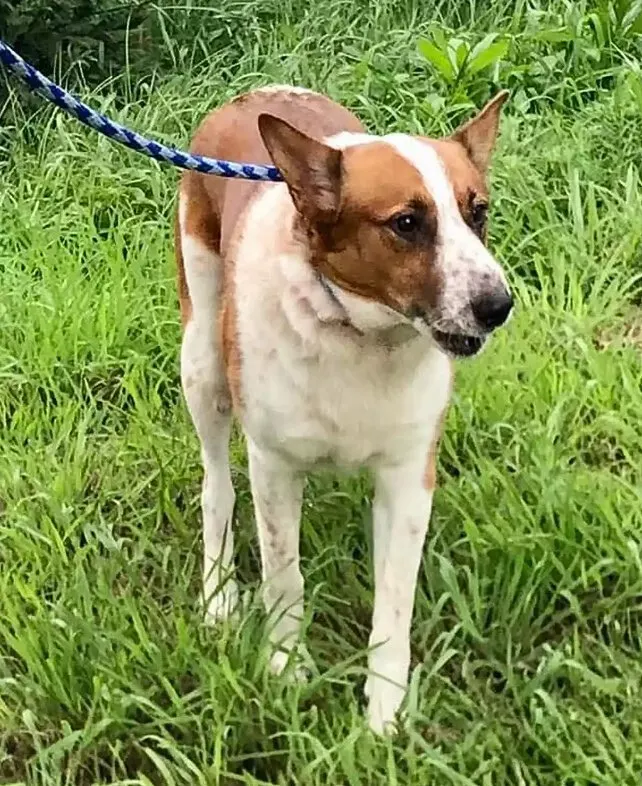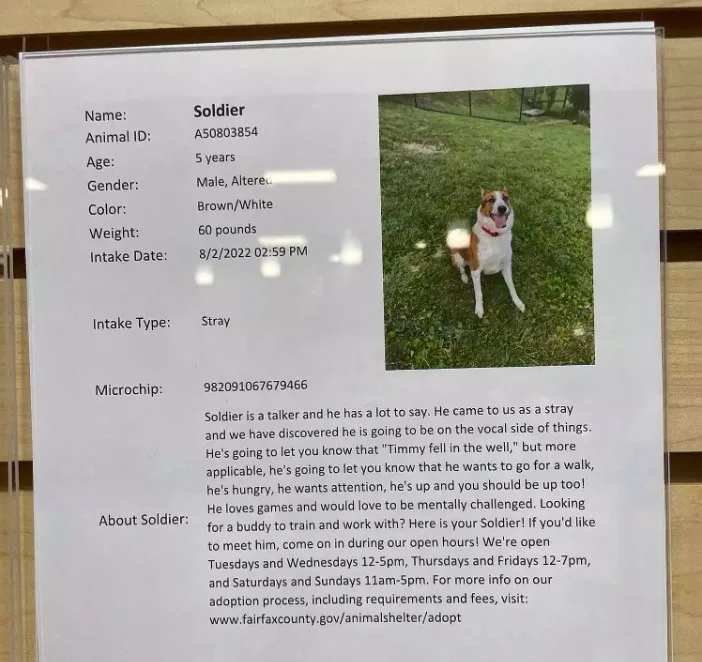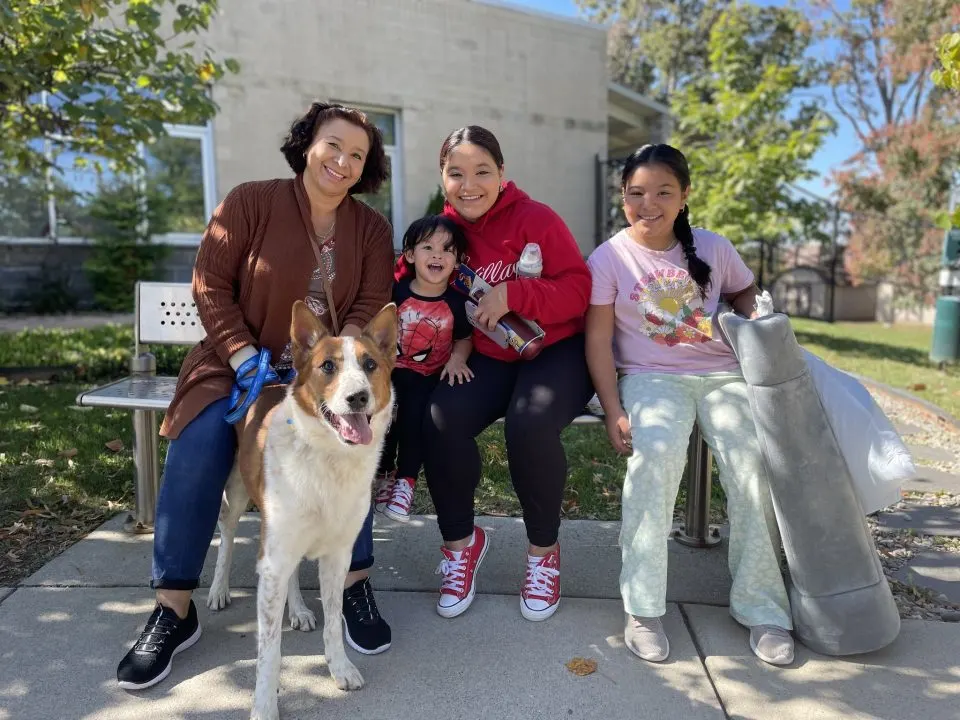Ruth Parada de Martinez and her daughters will never forget the day when their loving pup, Dante, went missing.
During one of his walks, Dante suddenly got off his leash and ran after the other dogs. He disappeared out of sight, leaving his family brokenhearted.
Dante was a beloved family member, and Ruth and her daughters couldn’t imagine their life without him. The pup meant the world to them.
They frantically searched for him, but he was nowhere to be found and nobody knew anything about him.
Trying To Move on

The family adopted him in 2017 when Ruth’s eldest daughter found out that she had lymphoma.
Dante was just a puppy and he brought so much joy to his family. He was a constant support to them until July 26th of 2022 – the day he went missing.
Ruth and her children had a hard time moving on. All they could think about was their loving pup who was no longer with them.
Deeply saddened, the family decided to move to another town in Virginia, 20 miles away from their former home.
Dante Ends Up In A Shelter

In August of 2022, a Good Samaritan noticed a sweet dog in Burke, Virginia, and she brought him to the Fairfax County Animal Shelter.
The pup was a real sweetheart and he stole the hearts of the shelter staff.
They wished to find his owners, but unfortunately, the friendly stray didn’t have a collar or a microchip. They also searched for lost dog reports, but nothing came up.
The staff named him “Soldier”.
They focused on helping the pup find a great home. Since the dog was adorable and friendly, the shelter believed that he would soon find a family.
“Soldier” met a couple of families who were interested in him, but the pup was reserved. He didn’t want to interact with them. At the time, the shelter staff didn’t know that Dante’s heart was filled with immense love for his family.
“… He shut down during all his meet-and-greets — there was just a little bit of a sadness about him. We kept talking about it in staff meetings: ‘Why isn’t this beautiful, playful boy getting adopted?’ We couldn’t figure it out. And then, of course, we realized he was waiting for his family,” Reasa Currier, the director of the shelter, told PEOPLE.
In October of 2022, Ruth, her two daughters, and her grandson arrived at Fairfax County Animal Shelter. They came to the shelter with the intention of adopting a dog.
The family looked at the adoption kennels, but they didn’t feel connected with any of the dogs. Just as they were about to leave, the most surprising thing happened.
An Emotional Reunion With Dante

While Ruth’s daughter, Kayla Martinez, was looking at the pictures of dogs on a wall in the shelter’s lobby, she noticed a familiar face. Her heart jumped with joy when she recognized that it was the sweet face of their Dante.
When she told her mom that the pup in the picture was Dante, Ruth couldn’t believe it. She explained to her daughter that the dog’s name was Soldier.
Kayla started crying. She was sure that it was their loving pup. Since her daughter insisted, Ruth asked the staff to see the dog.
The moment the pup saw his family, his whole body wiggled with happiness. He was over the moon to see them.
Ruth and her children cried tears of happiness when they saw their precious Dante in front of them. The pup started jumping with joy. His family ran to him and wrapped their arms around him.
Dante felt immensely happy. He never stopped believing that his family would find him.
Ruth showed the shelter staff Dante’s pictures when he was just a puppy, and she thanked them for taking care of their boi.
The next day, she took Dante home, feeling relieved that their nightmare was over. The beautiful pup was overjoyed to be back with his family.
Dante’s story highlights the importance of getting our dogs microchipped. If the delightful canine had a microchip, he would have been reunited with his family shortly after arriving at the shelter.
If you’ve ever wondered why your furry friend seems to be catching z’s more often than not, you’re not alone. As a seasoned dog trainer, I’ve seen this behavior time and time again in our canine companions. It’s a common sight to find your dog curled up in dreamland, but have you ever stopped to ponder the reasons behind their prolonged naps?
Your dog’s snooze marathon might have you scratching your head, but there’s more to it than meets the eye. Understanding the factors that contribute to your pup’s love for lounging can shed light on their sleeping habits. So, before you start nudging them awake, let’s take a closer look at why your dog might be clocking in extra hours in dreamland.
Understanding Your Dog’s Sleep Cycle
The Average Sleep Needs of Dogs
Dogs, much like their human companions, require a good amount of sleep to stay healthy and happy. On average, adult dogs spend about 12 to 14 hours a day sleeping. Puppies and senior dogs, on the other hand, may need up to 18 hours of sleep daily. Understanding your dog’s specific breed and age is crucial in determining its optimal sleep amount. Some breeds are naturally more active and may require slightly less sleep, while others, especially larger breeds, may need more rest to recharge.
Factors That Influence Sleep Duration
Various factors can influence how long your dog sleeps. Physical activity levels, mental stimulation, and overall health play significant roles in determining your dog’s sleep duration. Dogs that engage in regular exercise are often more tired and require more rest. Similarly, mental stimulation through training, play, and social interaction can impact how much sleep your dog needs. Health conditions, stress, and environmental factors can also affect your dog’s sleep patterns. Monitoring your dog’s sleeping habits can help you identify any changes that may indicate underlying health issues or other concerns.
Health Implications of Excessive Sleep
When to Worry About Your Dog’s Sleeping Habits
If you notice a sudden increase in your dog’s sleeping time or a significant change in their usual routine, it might be a cause for concern. Dogs are creatures of habit, and alterations in their sleep patterns could indicate underlying health issues. Keep an eye out for excessive lethargy, trouble waking up, or sleeping in unusual places. These changes could be signs that your furry friend needs a visit to the vet for a check-up.
Common Health Issues Related to Sleep
Excessive sleep in dogs can sometimes signal health problems that need attention. Conditions such as hypothyroidism, diabetes, or even heart disease can lead to increased drowsiness in dogs. Additionally, obesity can contribute to excessive sleep as it puts a strain on their bodies, causing them to feel tired more often. If you suspect that your dog is sleeping more than usual and it’s affecting their overall wellbeing, it’s essential to consult with a veterinarian to rule out any underlying health issues.
The Role of Age in Sleep Patterns
Puppies and Sleep: Growing Bodies Need Rest
When it comes to puppies, their sleeping habits are essential for their growth and development. Puppies spend a significant amount of time sleeping, up to 18 hours a day. This extensive sleep is crucial as it supports their physical and mental development. As young pups explore the world around them, their brains are processing a lot of new information, leading to the need for adequate rest to support cognitive development.
Senior Dogs: Adjusting to Their Slowing Pace
As dogs age, their activity levels decrease, and they tend to slow down. Senior dogs, usually age seven and older, require more rest due to their reduced energy levels and changing physical capabilities. It’s common for older dogs to sleep for extended periods, up to 18 hours a day. This increased sleep time is vital for senior dogs to rejuvenate their bodies and provide them with the necessary rest to cope with the natural aging process.
These sleep patterns change throughout a dog’s life, with puppies needing plenty of rest for growth and development, while senior dogs require more sleep to support their aging bodies. Understanding these age-related sleep needs can help you ensure your furry friend’s overall well-being as they journey through different life stages.
Behavioral and Environmental Influences on Sleep
How Your Routine Affects Your Dog’s Sleep
Your daily routine directly impacts your dog’s sleep patterns. Dogs are creatures of habit, so maintaining a consistent schedule helps regulate their sleep. If you suddenly change your routine, especially in feeding or exercise times, it can disrupt your dog’s sleep. Ensure that your dog gets enough physical activity during the day to promote a restful night’s sleep. Remember, a tired pup is a sleepy pup!
Creating a Comfortable Sleep Environment
Creating a cozy sleep environment is crucial for your dog’s rest. Provide a comfortable bed in a quiet and dark area of your home where they can sleep without disturbances. Make sure the temperature is comfortable, not too hot or too cold, as extreme temperatures can affect your dog’s sleep quality. Offering a familiar blanket or toy can also provide comfort and enhance their sleeping experience.
Remember, by establishing a consistent routine and ensuring a comfortable sleep environment, you can significantly contribute to your dog’s overall well-being and help them get the quality sleep they need.
How to Monitor and Improve Your Dog’s Sleep
Tracking Sleep Patterns
To monitor your dog’s sleep patterns effectively, start by keeping a sleep journal. Note down the times your dog goes to sleep and wakes up, along with any unusual behaviors during the night. This can help identify any disruptions in their sleep routine. Consider using a dog activity monitor that tracks their rest and activity levels, providing valuable insights into their sleep quality.
Tips for a Better Sleep Routine for Your Dog
Establish a consistent schedule for feeding, exercise, and bedtime to regulate your dog’s sleep-wake cycle. Ensure your dog gets enough physical activity during the day to promote restful sleep at night. Create a cozy and quiet sleeping environment, free from distractions and noise. Invest in a comfortable dog bed that offers proper support and warmth. Avoid feeding your dog right before bedtime to prevent digestive issues that may disrupt their sleep.
Conclusion
Your dog’s sleep habits are influenced by various factors such as breed, age, physical activity, and health. By monitoring their sleep patterns and providing a consistent routine, you can help ensure they get the rest they need. Remember to consider their individual needs and make adjustments to promote a comfortable and peaceful sleep environment. Prioritizing your dog’s sleep is essential for their overall well-being and happiness. So, pay attention to their sleep cues, establish a healthy routine, and watch them thrive with quality rest.
Frequently Asked Questions
How many hours should adult dogs sleep daily?
Adult dogs should sleep approximately 12 to 14 hours per day.
How much sleep do puppies and senior dogs require?
Puppies and senior dogs may need up to 18 hours of sleep daily.
What factors can affect a dog’s sleep needs?
Physical activity, mental stimulation, and health can impact a dog’s sleep requirements.
How can I monitor and improve my dog’s sleep?
Keep a sleep journal to track sleep patterns and use a dog activity monitor for insights.
What are some tips for promoting a dog’s restful sleep?
Establish a consistent schedule for feeding, exercise, and bedtime, ensure adequate physical activity, create a cozy sleeping environment, and avoid feeding right before bedtime.
[no_toc]

Hey there, I’m Janet Brooks, a dog-loving student from California. I’m all about helping pups in need, especially those without homes. Me and my awesome friends work together to give shelter and love to stray dogs. Oh, and I also write blogs about dogs to share helpful info.